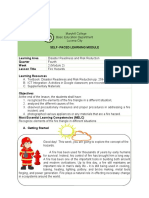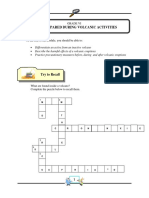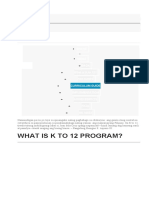Daily Lesson Plan 1
Daily Lesson Plan 1
Uploaded by
Froilan VillanuevaCopyright:
Available Formats
Daily Lesson Plan 1
Daily Lesson Plan 1
Uploaded by
Froilan VillanuevaOriginal Description:
Copyright
Available Formats
Share this document
Did you find this document useful?
Is this content inappropriate?
Copyright:
Available Formats
Daily Lesson Plan 1
Daily Lesson Plan 1
Uploaded by
Froilan VillanuevaCopyright:
Available Formats
SCHOOL AGUSUHIN HIGH SCHOOL SUBJECT DRRR
DAILY LESSON GRADE 12 AGUNALDO QUARTER 2ND QUARTER
PLAN TEACHER FROILAN S. VILLANUEVA ADVISER/T-II DATE 08/22/19
I. LEARNING COMPENTENCY
Explain various volcano-related hazards (DRR11/12-Ih-i-22)
Differentiate among different volcano hazards (DRR11/12-Ih-i-23)
OBJECTIVES:
a. identify the most common volcano-related hazards in the Philippines
b. explain the differences of the various volcano-related hazards
II. SUBJECT MATTER:
A. Topic: Volcano Hazard
B. Sub topics: Different Types of Volcanic Hazard
C. Materials: PowerPoint, Projector, Blackboard and chalk
D. Reference: Disaster Readiness and Risk Reduction
Teachers Guide: Lesson Guide in Senior High DRRR pp.67-77
III.PROCEDURES:
Prayer
Checking of Attendance
A. Review
Review the key points in the discussion of Earthquake from the previous lesson.
Ask the student if they really understand the past lesson
B. Motivation
1. Show photos of impacts of volcanic eruptions
2. What do we have here? (2 kinds of eruption, one violent or explosive and one effusive or quiet)
C. Activities
Ask the class to name several volcanoes they know
Ask the class what do they know about major volcanic eruptions in the Philippines?
D. Discussion
Introduce volcanic hazards
Dscuss the list of volcanic hazards common in Philippine active volcanoes
E. Application
Activity
1. Attributing impacts to specific hazards as discussed
2. ask learners to identify which type of volcanic hazards are present in the 6 most active
volcanoes of the Philippines
3. Let the learners have time to explain and discuss the answers
IV. EVALUATION:
Quiz - True or False?
1. Pyroclastic flows and surges are potentially highly destructive owing to their mass, high temperature, high
velocity and great mobility.
2. Lahars are rapidly flowing thick mixture of volcanic sediments (from the pyroclastic materials) and water,
usually triggered by intense rainfall during typhoons, monsoons and thunderstorms. Lahars can occur
immediately after an eruption or can become long-term problem for as long as there are excess sediments
on the volcano’s slope and water to remobilize these.
3. Lava flows are considered the most dangerous type of hazard from a volcano and is always a big threat
to human lives.
4. During eruption, excessive ashfall is dangerous as it can cause poor or low visibility.
5. Ash from volcanoes are also abrasive, because of this, ash suspended in air is also dangerous for
airplanes as this can cause the engines to fail if the suspended ash is encountered by the airplane
V. ASSIGNMENT:
1. Research about Volcanic eruption of the most active volcanoes of the Philippines.
You might also like
- PNP Disaster Response HandbookDocument28 pagesPNP Disaster Response Handbookbatman14383% (6)
- Detailed Lesson Plan (DLP) Format: Learning Competency/ies: Explain How Typhoons Develop Code: S8ES - Iid-18Document1 pageDetailed Lesson Plan (DLP) Format: Learning Competency/ies: Explain How Typhoons Develop Code: S8ES - Iid-18Rovz GC BinNo ratings yet
- Answer KeyDocument3 pagesAnswer KeyFroilan Villanueva100% (1)
- Nutty 9-11 PhysicsDocument13 pagesNutty 9-11 PhysicsIan LavenderNo ratings yet
- 7es New DLL For ObservationDocument14 pages7es New DLL For ObservationHarvey Rulloda AsisNo ratings yet
- DRRR 12 2nd WeekDocument4 pagesDRRR 12 2nd WeekGenner Raz100% (1)
- DLP DRR LC 24Document3 pagesDLP DRR LC 24allanrnmanaloto100% (2)
- Lesson Plan For Classroom ObservationDocument8 pagesLesson Plan For Classroom ObservationMichael FernandoNo ratings yet
- The Elements of Fire TriangleDocument5 pagesThe Elements of Fire TriangleLonil BayongawanNo ratings yet
- DLL 16Document4 pagesDLL 16Marjorie BrondoNo ratings yet
- DRRR Activity Sheet 4 5Document5 pagesDRRR Activity Sheet 4 5Charm BallinanNo ratings yet
- Lesson Guide in Earth and Life Science I. ObjectivesDocument3 pagesLesson Guide in Earth and Life Science I. Objectivesallanrnmanaloto100% (1)
- EASE Module 12 Inside The Solid EarthDocument42 pagesEASE Module 12 Inside The Solid EarthArianne Alano100% (1)
- Feb 6-10 2017Document9 pagesFeb 6-10 2017Charline A. RadislaoNo ratings yet
- Grade Level Quarter / Domain Week & Day No. Page No.: Identifying Classroom Hazards That Can Lead To DisastersDocument8 pagesGrade Level Quarter / Domain Week & Day No. Page No.: Identifying Classroom Hazards That Can Lead To DisastersArgie Joy Marie AmpolNo ratings yet
- DRRR POWERPOINT Types of HazardsDocument19 pagesDRRR POWERPOINT Types of HazardsKelsey Gaile MaghanoyNo ratings yet
- DRRRM LC 9Document3 pagesDRRRM LC 9allanrnmanalotoNo ratings yet
- DRRR Module 2 Week 2 4thQ AnswerDocument9 pagesDRRR Module 2 Week 2 4thQ AnswerAshley Jade DomalantaNo ratings yet
- Detailed Lesson Plan For DRRR April 08, 2022Document5 pagesDetailed Lesson Plan For DRRR April 08, 2022allan torreonNo ratings yet
- CO 1 Sy 2021 2022 ADocument8 pagesCO 1 Sy 2021 2022 AManilyn Nunez100% (1)
- DRR11 12 Ia B 6Document3 pagesDRR11 12 Ia B 6allanrnmanalotoNo ratings yet
- Identifying Classroom Hazards That Can Lead To Disasters: Detailed Lesson PlanDocument7 pagesIdentifying Classroom Hazards That Can Lead To Disasters: Detailed Lesson Planargie joy marieNo ratings yet
- Interpreting GeoHazard MapsDocument10 pagesInterpreting GeoHazard MapsRoselyn Estrada Munio100% (1)
- DRR1112 IIc D 32Document5 pagesDRR1112 IIc D 32allanrnmanalotoNo ratings yet
- DLL DRRR Week 1Document8 pagesDLL DRRR Week 1NESTOR BARUN CORDERO JR.No ratings yet
- QUIZ - Geologic Processes Inside The EarthDocument1 pageQUIZ - Geologic Processes Inside The EarthCristina Maquinto100% (1)
- Natural Signs Impending Tsunami: Disaster Readiness and Risk ReductionDocument24 pagesNatural Signs Impending Tsunami: Disaster Readiness and Risk ReductionGian Carlo PreNo ratings yet
- Physical Science - Day 56Document6 pagesPhysical Science - Day 56Maria Sheila OtlangNo ratings yet
- Volcanic HazardsDocument65 pagesVolcanic HazardsJohn MalgapoNo ratings yet
- Quiz 1 DRRRDocument1 pageQuiz 1 DRRRGail GailNo ratings yet
- Detailed Lesson Plan (DIFFERENT TYPES OF VOLCANIC ERUPTION)Document5 pagesDetailed Lesson Plan (DIFFERENT TYPES OF VOLCANIC ERUPTION)ncplmrsNo ratings yet
- Natural Hazards, Mitigation, and Adaptation: Quarter IDocument25 pagesNatural Hazards, Mitigation, and Adaptation: Quarter IMhelds Parags50% (2)
- Apply Mitigation Strategies (DRRR)Document40 pagesApply Mitigation Strategies (DRRR)Randel Nel JunianNo ratings yet
- SHS-DLL-pr2 Week 9Document3 pagesSHS-DLL-pr2 Week 9Alvin PaboresNo ratings yet
- Table of Specification Disaster Readiness and Risk Reduction 2nd Semester FINAL EXAMDocument2 pagesTable of Specification Disaster Readiness and Risk Reduction 2nd Semester FINAL EXAMRICHARD CORTEZNo ratings yet
- DLL DRRR Quarter 1 Week 5Document5 pagesDLL DRRR Quarter 1 Week 5Maria Lourdes PunayNo ratings yet
- Department of Education Region III: I. ObjectivesDocument3 pagesDepartment of Education Region III: I. ObjectivesallanrnmanalotoNo ratings yet
- My Family Emergency Preparedness PlanDocument8 pagesMy Family Emergency Preparedness PlanJuriel Elohim GolvinNo ratings yet
- Lesson Exemplar Final FormatDocument3 pagesLesson Exemplar Final FormatHello123No ratings yet
- Grade 1 To 12 Daily Lesson LOG: I. ObjectivesDocument5 pagesGrade 1 To 12 Daily Lesson LOG: I. ObjectivesAsniah Takiri McrndsNo ratings yet
- Budget of Lesson in Disaster Readiness and Risk ReductionDocument1 pageBudget of Lesson in Disaster Readiness and Risk Reductionmichael hobayan100% (1)
- DLL Jeclyn DaissDocument5 pagesDLL Jeclyn DaissJeclyn D. FilipinasNo ratings yet
- Summative Test in DRR FinalDocument4 pagesSummative Test in DRR FinalEsther Macugay100% (1)
- Q4 - DRR - Activity 1Document4 pagesQ4 - DRR - Activity 1Ethylaine ApilanNo ratings yet
- Department of Education: Republic of The PhilippinesDocument6 pagesDepartment of Education: Republic of The PhilippinesMARGIE BOGANOTANNo ratings yet
- 1st Quarter ExamDocument3 pages1st Quarter Examrheza oropaNo ratings yet
- Disaster Readiness and Risk ReductionDocument22 pagesDisaster Readiness and Risk Reductionwendell john medianaNo ratings yet
- DRRR ST1Document2 pagesDRRR ST1Alvin Gultia100% (2)
- Marinduque National High School: Department of Education MIMAROPA Region Isok 1, Boac, MarinduqueDocument4 pagesMarinduque National High School: Department of Education MIMAROPA Region Isok 1, Boac, MarinduqueMaria Joy VelascoNo ratings yet
- Authentic, Standard-Based Performance Task in Earth and Life Science 1st Quarter of S.Y. 2021-2022Document2 pagesAuthentic, Standard-Based Performance Task in Earth and Life Science 1st Quarter of S.Y. 2021-2022Ken SugiyamaNo ratings yet
- Es Quiz 2.1 EARTHS INTERNAL HEAT AND GEOLOGICAL PROCESSESDocument2 pagesEs Quiz 2.1 EARTHS INTERNAL HEAT AND GEOLOGICAL PROCESSESJie Muska CalejaNo ratings yet
- QUIZDocument4 pagesQUIZrheza oropaNo ratings yet
- Hydrometeorological HazardDocument48 pagesHydrometeorological HazardMar ArizalaNo ratings yet
- DAILY LESSON LOG School Tibagan NationalDocument5 pagesDAILY LESSON LOG School Tibagan NationalMay Paquillo-impuesto100% (1)
- Inventory List For Laboratory in ScienceDocument2 pagesInventory List For Laboratory in ScienceRuvy Jean Codilla-FerrerNo ratings yet
- DRR11,12 Ic 9Document4 pagesDRR11,12 Ic 9ben lee100% (1)
- DLL DRRR 3rd Week 1st Day PDF FreeDocument2 pagesDLL DRRR 3rd Week 1st Day PDF FreeApril Mae ArcayaNo ratings yet
- Volcanic HazardsDocument5 pagesVolcanic Hazardsalfredo cancioNo ratings yet
- S11ES Ij 22Document2 pagesS11ES Ij 22allanrnmanalotoNo ratings yet
- Being Prepared During Volcanic Activities PDFDocument10 pagesBeing Prepared During Volcanic Activities PDFRei Panisales ValdezNo ratings yet
- Earthquake HazardsDocument44 pagesEarthquake HazardsMiss Rona100% (1)
- Specific Learning Outcome: Grade 12 - South Korea 10:00 - 11:00 (M-TH) Grade 12 - Turks & Caicos 11:00 - 12:00 (M-TH)Document2 pagesSpecific Learning Outcome: Grade 12 - South Korea 10:00 - 11:00 (M-TH) Grade 12 - Turks & Caicos 11:00 - 12:00 (M-TH)Joshua ManalonNo ratings yet
- Different Types of Volcanic HazardsDocument37 pagesDifferent Types of Volcanic Hazardsmariafelez.matignao01No ratings yet
- Questions SD D U A SDDocument3 pagesQuestions SD D U A SDFroilan VillanuevaNo ratings yet
- What Is K To 12 Program?Document33 pagesWhat Is K To 12 Program?Froilan VillanuevaNo ratings yet
- Sample DATA GATHERING INSTRUMENT FOR TRAINEESDocument2 pagesSample DATA GATHERING INSTRUMENT FOR TRAINEESFroilan VillanuevaNo ratings yet
- PRMSUDocument1 pagePRMSUFroilan VillanuevaNo ratings yet
- EnglishDocument6 pagesEnglishFroilan VillanuevaNo ratings yet
- Acr ESPDocument1 pageAcr ESPFroilan Villanueva100% (2)
- Republic of The Philippines Department of Education Region III School Division of Zambales Municipality of Subic School ID: 301013Document1 pageRepublic of The Philippines Department of Education Region III School Division of Zambales Municipality of Subic School ID: 301013Froilan Villanueva0% (1)
- Judgement/Decesion Making 5 4 3 2 1 NADocument1 pageJudgement/Decesion Making 5 4 3 2 1 NAFroilan VillanuevaNo ratings yet
- Use The Following Molar Masses: N2 28 G/mol, NH3 17g/mol, and H2 2 G/molDocument2 pagesUse The Following Molar Masses: N2 28 G/mol, NH3 17g/mol, and H2 2 G/molFroilan VillanuevaNo ratings yet
- Long Quiz PhyscieDocument1 pageLong Quiz PhyscieFroilan VillanuevaNo ratings yet
- Mid-Term in Philippine GeographyDocument6 pagesMid-Term in Philippine GeographyFrancis Joseph V BatuigasNo ratings yet
- M. S. Silk - Heracles and Greek TragedyDocument23 pagesM. S. Silk - Heracles and Greek TragedyFidel AndreettaNo ratings yet
- 1 - ERP - CrisisDocument124 pages1 - ERP - Crisisamira_zainal92No ratings yet
- Tess TragedyDocument4 pagesTess TragedyRuxandra Onofras0% (1)
- Quarter 2 - Module 4: Understanding Typhoons: ScienceDocument33 pagesQuarter 2 - Module 4: Understanding Typhoons: ScienceCharity Bantigue100% (11)
- Bombing of Hiroshima: Operations Order No. 35 Tinian Charles SweeneyDocument2 pagesBombing of Hiroshima: Operations Order No. 35 Tinian Charles SweeneyMuhammad Irham PurnomoNo ratings yet
- Bojan Dorina, Orajele in Tara ZaranduluiDocument5 pagesBojan Dorina, Orajele in Tara ZaranduluiNedelcu Mihai-ClaudiuNo ratings yet
- Fire Safety Disaster PlanningDocument20 pagesFire Safety Disaster PlanningprabhatNo ratings yet
- Discuss The View That With An Increasing Global Need For Energy, All Energy Sources Should Be Exploited To The Fullest.Document2 pagesDiscuss The View That With An Increasing Global Need For Energy, All Energy Sources Should Be Exploited To The Fullest.Kexin QiuNo ratings yet
- Tugas Tutorial Ke 2Document4 pagesTugas Tutorial Ke 2Abdulloh Sya'banaNo ratings yet
- Recount TextDocument3 pagesRecount TextFerina YollandaNo ratings yet
- Report On The Conduct of Quarterly National Simultaneous Earthquake DrillDocument3 pagesReport On The Conduct of Quarterly National Simultaneous Earthquake DrillRichard S.PicazaNo ratings yet
- ASCE 7-05 Minimum Base Shear For Computing DriftDocument2 pagesASCE 7-05 Minimum Base Shear For Computing DriftA1 VideoNo ratings yet
- Breccia Poster VancouverDocument1 pageBreccia Poster VancouverAlonzo100% (2)
- Seismic Assessment of A Cable-Stayed Arch Bridge Under Three-Component Orthotropic Earthquake ExcitationDocument16 pagesSeismic Assessment of A Cable-Stayed Arch Bridge Under Three-Component Orthotropic Earthquake ExcitationJuan BravoNo ratings yet
- Chapter 02 Reading Astrological Weather ChartsDocument18 pagesChapter 02 Reading Astrological Weather Chartschiraki100% (1)
- Perkin Expert ReportDocument263 pagesPerkin Expert ReportOSDocs2012No ratings yet
- First Aid: Context and Issues: Training Packages For Health EmergenciesDocument29 pagesFirst Aid: Context and Issues: Training Packages For Health EmergenciesKylah Joy BautistaNo ratings yet
- The Earthquake: About EarthquakesDocument3 pagesThe Earthquake: About Earthquakeslance pascuaNo ratings yet
- Fire Drill ProcedureDocument2 pagesFire Drill ProcedurekhaysiaNo ratings yet
- Lesson 3: Fire: Prevention and ResponseDocument8 pagesLesson 3: Fire: Prevention and ResponseMicaella GuintoNo ratings yet
- The Tenerife Airport DisasterDocument3 pagesThe Tenerife Airport DisasterSonja JeynNo ratings yet
- Erowid Experience Vaults Report Id: 91439: The AwakeningDocument5 pagesErowid Experience Vaults Report Id: 91439: The Awakeninggreat2readNo ratings yet
- DRRR Student Guide LM1Disaster 2021Document13 pagesDRRR Student Guide LM1Disaster 2021spicypusa69No ratings yet
- Understanding The Impact of Disasters On The Lives of Children and YouthDocument3 pagesUnderstanding The Impact of Disasters On The Lives of Children and YouthWowo Masthuro MahfudNo ratings yet
- DR CVR Murty - SefiDocument4 pagesDR CVR Murty - SefiVarad Sonawadekar0% (1)
- Checklist of Actions and Milestones For Earthquake PreparednessDocument7 pagesChecklist of Actions and Milestones For Earthquake PreparednessmeljamerlanNo ratings yet
- 8-Pipe Fitting Risk Assessment ReportDocument8 pages8-Pipe Fitting Risk Assessment ReportSyed Ali HassanNo ratings yet




































































































